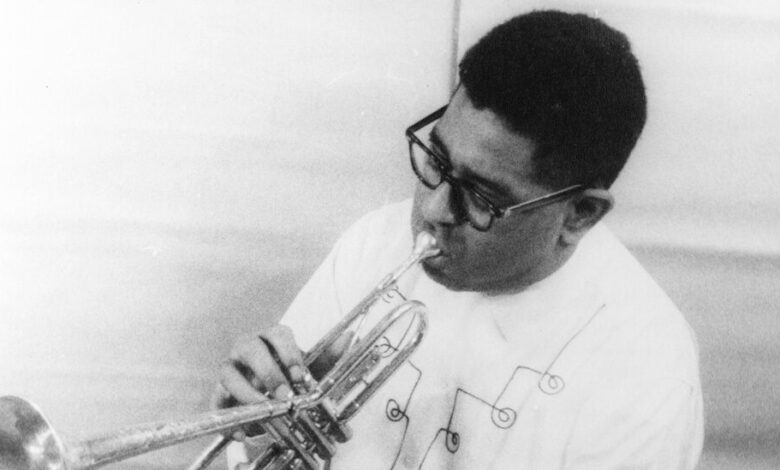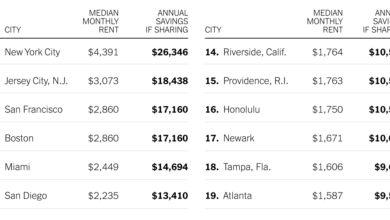The Rich History of Jazz in Queens

[ad_1]
Dizzy Gillespie helped make Minton’s Playhouse famous.
Minton’s in Harlem was where jazz musicians, from out-of-towners to locals performing in nearby big band theaters in Harlem, sought refuge during late-night jam sessions and a new genre, bebop, was born. Gillespie, together with Charlie Parker, is largely considered a pioneer of the rebellious jazz style that diverged from mainstream swing jazz’s emphasis on orchestrated productions and collective harmony. Instead, it ushered in an era of artistic experimentation that better reflected the realities of Black urban life and the talents of Black musicians.
“Jam sessions, such as those wonderfully exciting ones held at Minton’s Playhouse, were seedbeds for our new, modern style of music,” Gillespie wrote in his autobiography, “To Be or Not to Bop.”
But there was another gathering spot for Gillespie and his peers: the three-story Colonial Revival-style building in Corona, Queens, that he bought in 1953.
Jazz clubs were in Harlem. But jazz musicians lived on the tree-lined streets of Queens. While white musicians skedaddled to the suburbs, Black jazz virtuosos sought solace in the neighborhoods where their racial identity was welcomed — ultimately congregating into two enclaves in the borough. The first was in the southeast by Addisleigh Park where the composer Clarence Williams and his wife moved in the 1930s, with Count Basie, Lena Horne, Duke Ellington’s son, Mercer Ellington, and James Brown eventually following suit. The second was in Corona, where Louis Armstrong lived until his death, and a place that Gillespie, fellow trumpeter Clark Terry, and Ella Fitzgerald once called home.
Queens had the charm of the South, conveniences of the northern lifestyle and was close enough to the teeming jazz scene of Harlem without being ensnared. The borough didn’t generate a fresh jazz genre like Harlem. But the borough was an incubator where music got worked out, imagined and revised, as Black musicians were grappling with the commercialization of their craft.
In June, the New York City Landmarks Preservation Commission honored the formal and informal spaces from which New York’s jazz scene spawned and flourished by designating three sites as landmarks for their cultural significance to modern jazz — the building at 935 St. Nicholas Avenue in Washington Heights where Duke Ellington and Noble Lee Sissle once lived; Minton’s and its home the Hotel Cecil; and Gillespie’s house at 105-19 37th Avenue in Corona.
Although Gillespie lived in Corona after bebop had been established as a genre, he continued to hone his craft while living in Queens. He adopted his iconic bent trumpet and recorded several popular albums, including “Jazz at Massey Hall” (1954), and “Manteca” (1958), “and appeared live in 1956 from his home in a broadcast interview on Edward R. Murrow’s “Person to Person” television program.
Gillespie often invited fellow musicians to his basement to play alongside him.
“Dizzy, Babs Gonzales, and I would mainly spend time down in the basement because that’s where he would rehearse,” said Ernest Gillespie, Dizzy’s cousin. Ernest Gillespie, now 96, lived in nearby East Elmhurst during that time and currently resides in Fresh Meadows, Queens.
The basement housed a full set of drums, a piano, and eventually a pool table and train set. The fridge in the basement was always stocked with Carlsberg Elephant, his favorite beer. The walls were adorned with art from other countries, souvenirs collected during his time as the nation’s first jazz ambassador. Starting in 1956, the State Department financed Gillespie and his band to travel across the world promoting democratic values.
Gillespie also nurtured many up-and-coming musicians. “I met Count Basie, Ella Fitzgerald, and Junior Mance in that basement,” said Dizzy’s godson, Harris Stratyner, now 68, who was a budding saxophone and clarinet player at the time. “Dizzy really was a teacher. He would teach the young cats how to play and how to follow rhythms and it all happened in his basement in Corona.”
Jeanie Bryson, 65, Gillespie’s daughter and an accomplished singer in her own right, lived in nearby LeFrak City along with her mother, the composer Connie Bryson, who was never married to Gillespie.
The father-daughter relationship, hidden from public view, was limited, but Ms. Bryson recalled how her father would visit and she remembered his mentorship of musicians fondly.
“He helped so many young musicians from different countries and gave these guys an opportunity that was beyond their imagination at the time,” Ms. Bryson said.
Gillespie was married to Lorraine Gillespie, who was also his personal manager. They had no children together, but they built a family in the neighborhood. On the outside, their home was an ordinary red brick building much like the other homes in the area, including their neighbor’s, Louis Armstrong, who lived around the corner. Armstrong’s home was designated a historic landmark in 1988 and opened for public tours in 2003.
Armstrong bought a home in Corona with his wife, Lucille Armstrong, in 1943, a full decade before the Gillespies. Here, he carved out a humble life in a neighborhood of predominantly Italian immigrants and a growing community of middle-income Black residents. “We’re right out here with the rest of the colored folk and the Puerto Ricans and Italians and the Hebrew cats,” Armstrong told Ebony magazine in 1964. “What the hell I care about living in a ‘fashionable’ neighborhood?”
His classic hit, “What a Wonderful World,” was written by Bob Thiele and David George Weiss as a tribute to Armstrong’s beloved Corona.
The demographics of the neighborhood have changed in the decades since, with Latino immigrants replacing Italian immigrants in the 1960s, drawn by relatively affordable real estate and a welcoming attitude, the same forces that once lured Black newcomers. Now, the neighborhood is a hub for the next generation of Mexican, Ecuadoreans and Dominican residents.
There are very few public acknowledgments of the period when Black musicians called Corona home. The Corona East Elmhurst Historic Preservation Society has long argued that the city’s Landmarks Preservation Commission has not properly recognized the historical significance of Queens properties. The society filed the initial petition in 2015 to have Gillespie’s home designated a landmark, but was denied. “Corona East Elmhurst, with its rich history and significant traditions is in jeopardy of becoming a negligible factor in the thought of the world,” the group wrote in the initial petition.
“We felt we needed to create this society to preserve, protect, and promote the history and legacy so future generations will know the greatness of the community,” said Deborah Tyson, one of the founders of the local society.
The landmarking of Gillespie’s home is a step toward memorializing both a jazz legend and a moment when jazz musicians sought refuge in the borough, often overshadowed by the legacy of Harlem and places like Minton’s.
Minton’s Playhouse opened on the first floor of the former Hotel Cecil in 1938, a year before the start of World War II. As riots, unemployment and discontent swung into the collective consciousness of Americans in the 1940s, Minton’s provided a sanctuary from wartime and racial tensions allowing Black musicians to tinker with musical styles without fear of retribution and to create new art forms. Bebop was a sonic chronicle of the world as its creators experienced it — a tapestry of anguish, discontent, and soul-stirring improvisation spun from within the marginalized spaces of the music industry.
“One of the really interesting things to think about as this designation is directed to the Hotel Cecil and Minton’s and to Dizzy Gillespie’s home is that it speaks to me of the ways bebop was quite famously developed in clubs like Minton’s, and especially Minton’s, but also a lot of those ideas got worked out in rehearsals that often happened in people’s homes,” said Eric Porter, a professor of history at University of California, Santa Cruz. “Whether they were rehearsing for a recording or just hanging out and thinking about music, the basement studios were really important for the development of bebop as well.”
Nonprofits in Queens are building on this moment. The Louis Armstrong House Museum is partnering with Flushing Town Hall and the Kupferberg Center for the Arts to create an interactive digital experience that maps the histories of jazz and hip-hop in Queens. This new effort builds upon the Queens Jazz Trail map originally commissioned by Flushing Town Hall in 1998.
Jazz fans “live across the country or the world and they may never make it to New York, but they are able to engage with our mission and with our stories,” said Regina Bain, the executive director of the Armstrong museum in a news release in 2022.
Across the street from the house museum sits the shiny, 14,000-square-foot Louis Armstrong Center which opened to the public in July. The Louis Armstrong Stadium at the USTA Billie Jean King National Tennis Center in Queens was rebuilt and reopened back in 2018, replacing the 1978 tennis stadium of the same name.
But education still needs to happen locally, particularly within the neighborhood’s public schools, Ms. Tyson said. “We’ve had a lot of musicians and significant people of color who have lived in our community and we wanted to tell the story because we want the children to know,” she said. “The teachers didn’t even know about all this information.”
For now, much of the history lives in the memories of residents who lived in the neighborhood as children or can recall their parents’ encounters. “My mother used to talk about how Dizzy Gillespie and Louis Armstrong would sit on their stoop and play out in the block and the kids would come around and hang about,” Ms. Tyson said.
The Queens Borough President’s Office, in collaboration with the Port Authority of New York and New Jersey, has been placing banners, murals and signage along the AirTrain’s John F. Kennedy Airport route from Jamaica, Queens, as a small, but insufficient attempt to bring awareness to the borough’s rich musical heritage.
“We need to try to preserve the history because there aren’t many people left who know the story of the community,” Ms. Tyson said. “We have places that are worthy of preservation. They may not look like a brownstone or a mansion on Fifth Avenue, but it doesn’t mean they aren’t worthy of preservation as well.”
[ad_2]
Source link






